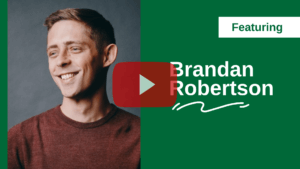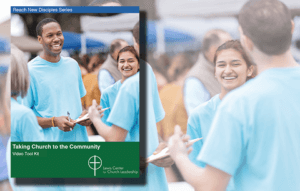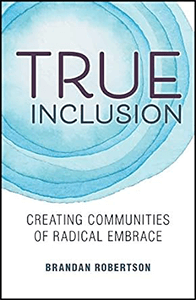
How can church leaders build an inclusive community of faith? In this episode Jessica Anschutz of the Lewis Center staff speaks with Brandan Robertson, the “Tiktok Pastor,” about social media ministry, intersectional inclusivity, and the challenges of building inclusive community.
Listen on Apple Podcasts | Google Podcasts | Spotify
Watch on YouTube

- Transcript — Click or Tap to Read
-
Announcer: Leading Ideas Talks is brought to you by the Lewis Center for Leadership of Wesley Theological Seminary in Washington, DC. Subscribe free to our weekly e-newsletter, Leading Ideas, at churchleadership.com/leadingideas.
Leading Ideas Talks is also brought to you by the Taking Church to the Community Video Tool Kit. Explore strategies your congregation can use to reach beyond its walls with worship, community events, ministries, and service. Learn more and watch introductory videos at churchleadership.com/shop.
How can church leaders build an inclusive community of faith? In this episode Jessica Anschutz of the Lewis Center staff speaks with Brandan Robertson, the “Tiktok Pastor” about social media ministry, intersectional inclusivity, and the challenges of building inclusive community.
Jessica Anschutz: Welcome to Leading Ideas Talks, a podcast featuring thought leaders and innovative practitioners. I am Jessica Anschutz, the assistant director of the Lewis Center for Church Leadership, and I am your host for this Leading Ideas Talks. Joining me is Rev. Brandan Robertson who serves as the pastor of the Sunnyside Reform Church in Queens, New York, and who is also known as the “TikTok pastor.” He’s the author of True Inclusion: Creating Communities of Radical Embrace. He’s also an activist and public theologian working at the intersections of spirituality, sexuality, and social renewal. Thank you, Brandan, for taking time to speak with me today about your book and your ministry.
Brandan Robertson: Thanks for inviting me. I’m so excited to have this conversation.
Jessica Anschutz: Before we talk about your book, Brandan, I want to give you an opportunity to share with our listeners how you came to be known as the “TikTok pastor.”
Brandan Robertson: Yeah, it’s a surprising story to me, too, every time I go back and think about it because it really centers on the pandemic. The pandemic shifted so much for so many people. I was pastoring a community in San Diego at the time, and we had shut down our offices, shut down Sunday worship, were figuring out what going virtual meant. In my context, that meant that I had a lot of extra time automatically on my calendar because pastoral care all became virtual. There was a lot less traveling around.
So, I started exploring, just trying to find inspiration for how to pastor during the pandemic. I’d seen this app, TikTok, pop up and begin a conversation but thought it was for kids to post dancing videos or whatever, and I wasn’t very interested in getting it. But I saw a fellow clergy colleague in San Diego starting to post just fun videos in her clergy collar talking about theology. And seeing TikTok used that way, I wondered what it would look like if I decided to hop on with all my extra time now and see what happened. So, I started with a TikTok account, and my first probably 20 videos were pretty terrible. I tried to be funny and hip and cool and do all of the things that I thought the kids on TikTok would resonate with and none of that really worked.
About a month into it, I started just talking about theology because that’s my passion. I primarily see myself as a teacher and public theologian, and I love helping people articulate a progressive version of Christianity. I started just doing videos about various aspects of progressive Christianity and started noticing these videos getting 20,000, 30,000, 40,000 views and my follower count start just going up and up and up. I was blown away by how much talking about theology would resonate with the audience of TikTok, and that really began this journey that lit a passion in me for kind of re-evangelizing. Most of the people I get to talk to on TikTok are people who walked away from church or are turned off by Christianity because of what they see in the media. And they discover my account and now the hundreds of other progressive clergy that are on TikTok and are brought back to at least considering what it would look like to follow Jesus.
So, TikTok has become an obsession. It’s become part of my calling and part of my ministry, and I’m just really blown away by how this platform has enabled me to live out my calling as a pastor and someone proclaiming the good news of Jesus.
Jessica Anschutz: I love that story and think it’s just a wonderful story of innovation, of trying and failing and pivoting and sort of finding your place. What tips do you have for others who may want to use TikTok as a tool for ministry?
Brandan Robertson: Yeah, I think the easiest thing is to just get TikTok and start doing what you do. I think so many people, especially pastors, are paralyzed by feeling like they don’t know the ins and outs of a platform, so they never begin to experiment with it. There’s really no way that you can use TikTok or really any other social media platform wrong. There are ways that will end up being effective and get your content in front of lots of people and some that are not so effective and won’t be seen by tons of people. And all of it is good. All of it is good knowledge and can help train you in how to be an effective digital minister. I would say get on TikTok. Start talking about what you talk about.
The other thing people tend to think when they get on TikTok is that they have to create really highly curated content, content that’s been edited, content that has the perfect captions and the best lighting. I have found in my own story of “success” on TikTok — my videos are unedited, off the cuff. I record probably 10 videos in 20 minutes because each video is about a minute long. I sit down and I just speak from my heart what’s on my mind and post that immediately. And those videos get more traction because what people are looking for on TikTok more than anything is a sense of authentic connection. The person on the other side of the screen wants to feel like they’re just FaceTiming you or Zooming you or are just connecting with somebody in a very real way. Content that is overly produced and overedited on TikTok doesn’t perform well, so it’s a super accessible platform for people just to turn on their cameras, say what’s on their heart, put it out into the world, and see what happens.
What I do know is that people are starved for good news right now. People are starved for inclusive Christianity right now. And so more voices on a platform like TikTok is better for the mission that we’re all called to in the world. So, get on TikTok!
Jessica Anschutz: I appreciate your endorsement of TikTok, but most importantly, your endorsement of being our authentic selves when it comes to leadership in the church and in the community. I know that your social media presence and your messages of inclusion have not only brought millions of views but also quite a bit of critique which often comes for those of us who are in the spotlight of public ministry. What practices have helped sustain you in the midst of the criticism that comes along with your presence?
Brandan Robertson: Yeah, that’s a great question. I would be lying if I said that the criticism doesn’t always get to me. I think, whenever we enter into the digital realm, we need to be mindful that this is in our era — global. Everything you put on the internet is available to anyone in the world. There are lots of people in the world who will oppose what you’re saying or who you are or how you’re doing ministry, and there are a lot of people in the world that will do that in ways that are pretty horrendous.
On the one hand, I think most pastors have to learn how to have a thick skin and take some critique that will prepare you in some regards. But when you are also in the digital space, you’re going to come across people that go out of their way to do very unkind, sometimes scary, things. I’ve had people email me threats before and things like that. I would say the way I’ve dealt with that though personally is, one, having other friends in this space with me who I can talk to about how to respond if there is a particularly bad troll attacking or I am getting a kind of threatening email. Having a community of support around me and talking to other clergy about what to do and how to respond is very helpful because a lot of times when you’re responding to something like that that’s so negative that you do kind of get into flight or fight. And that mode is not a helpful mode to make decisions. So, having a sounding board is helpful.
The other thing is, obviously, since my ministry has moved primarily into the digital realm, I only recently stepped back into a brick-and-mortar church. I’ve really relied on therapy, which is something I think all pastors should have but especially if they’re going to be doing digital work because, again, stepping onto a digital platform, so to speak, exposes you in a way that you aren’t exposed in the four walls of your church. People will know things about you. On the positive side, if you get on TikTok and even if you just get a couple thousand followers, you might get recognized in public. As pastors, I think it’s important for us to have people to talk to about those instances, good and bad, to help keep our egos in check, to help keep us humble, to make sure we’re staying healthy.
Because social media can also become addictive, we can also very quickly start utilizing it for the wrong reasons. If it becomes just a way to get some more views, you’re going to find that your content begins to be inauthentic. You’re going to start saying things that you know people will respond to. So, for me, having a therapist in my life to talk about criticism but also just to talk about what it means to be doing ministry in such a public way has been a really helpful way to keep me grounded and keep me motivated to come back and do this ministry for another day.
Jessica Anschutz: The importance of personal and professional support in the midst of ministry is certainly key and I appreciate your willingness to lift both of those aspects up — the friends and colleagues and therapy. I want to shift now to your book, True Inclusion: Creating Communities of Radical Embrace. If our listeners haven’t had a chance to read it yet, I encourage them to do so. Your book focuses on intersectional inclusivity. How did you come to write about this?
Brandan Robertson: Yeah, that’s a great question, too. True inclusion as a book was not my idea. I had just stepped into pastoring a very diverse church, probably one of the more diverse churches I’ve ever seen before, and I was wrestling with the question — I’d spent so much time in my life and in my ministry advocating for LGBT inclusion in particular, now I was pastoring a church that was fully inclusive and hired me as an openly queer pastor and had racial diversity and was very mindful of people with different abilities and disabilities. We had all of it going on already. When I stepped in, I kind of breathed a sigh of relief and thought this wasn’t a conversation we were really going to need to have.
Then my publisher, Chalice Press, reached out to me and said, “Hey, we know that you’re doing inclusive ministry, but we’re getting a lot of people asking, what do you do next? Once your church becomes fully and ultimately inclusive, once your church embraces racial justice, once your church has women in leadership, what happens? Does the work stop there or is there more that we should be doing? When the publisher asked me to do that, I spent about a year looking at my community and asking that in the midst of our community. What does it mean for us to say that we’re inclusive and to have done a good job building an inclusive community thus far — but does it end here? Is that all the work? Do we just get to put that on our sign out front and be done with it?
What emerged was clearly a “no” to that question. There was always more work to do. And I explore in True Inclusion both practically what we had to do as a community when we became aware of more blind spots and people we were excluding and how we wrestled with those questions as an inclusive community. I looked back at the theology of Jesus, and one of the core grounding lines in the book is that Jesus calls us to take the gospel of inclusion to its logical conclusion, which means that we’re always looking beyond the four walls of our church and asking who isn’t showing up here and why? Who aren’t we thinking about the needs of and making it harder for them to step into the four walls of our church? Also, how are we utilizing our resources to those that will never step in to the four walls of our church? We’re rooted in this community for a purpose, and it’s not just so that we can build a more wealthy, big church. It’s so that we can bless and serve and heal this community.
True Inclusion, really, it’s a small book, but it’s meant to reflect on both those theological and personal experiences I had in my first few years pastoring that community. And I include some of the kind of the steps and practical processes we implemented to help us continue to see inclusion as a process that we didn’t give up after the end of some journey, but it was actually fundamental to what it meant to be a progressive, inclusive community. It was something we were always thinking about, always doing, always expanding.
Explore strategies your congregation can use to reach beyond its walls with worship, community events, ministries, and service. The Taking Church to the Community Tool Kit features engaging videos and presentations and is designed for both self-study and for use with groups in your church. Learn more and watch introductory videos now.
Jessica Anschutz: What are some of the risks that church leaders must be willing to take in order to be fully inclusive?
Brandan Robertson: That’s a great question because the truth is that becoming inclusive is not a strategy to grow your church. It’s one of the things I say first and foremost in the book. A lot of people tend to have the idea, as they begin thinking about moving their churches towards inclusion, that this is going to be a way to invite more and more people in. In one sense, you will get more diverse people in your church when you start leaning into the inclusion imperative. But when you become a truly inclusive church and center inclusion as your community’s core value, people in that church who are comfortable with the status quo, who are comfortable with the way things have been, who are comfortable with the people that have been showing up, are going to get very uncomfortable very quickly. I’ve seen it time and time again in every church I’ve pastored. As we pushed towards inclusion, we’ve lost people.
I also talk about the revolving door principle in True Inclusion, which means I, in my experience, and every other inclusive pastor I’ve talked to has had an experience of, once your church commits to inclusion, the front door of your church becomes revolving, meaning membership isn’t really a thing in radically inclusive churches. In very few, you might have a core group of people that become members and stick around and form the basis of the community. But more often than not, your community is going to be made up of people that are coming into the doors of your church for a place of healing because they’ve been harmed by the church, rejected by their religious family. They’re looking for a way to heal from their religious trauma; they come and be a part of your church for a while, and then they might move on. I see that. I think we need to reframe that. It’s actually success.
I think we need to shift how we view what the role of church is: not building massive Sunday morning services but rather having a community that’s a touch point for many people, where they know they can come and show up and get healed. They can come, show up, and do justice in the community. But they might not be there every Sunday. And as you lead people on this journey towards healing and radical inclusion, membership shifts. The way we look at who makes up our church needs to shift. That can be really shocking if you’re not prepared for it. I’ve had so many consulting calls with pastors that are just devastated and frustrated because they’ve done the right thing and they’ve lost a lot of people. But I think that’s what we’re called to do and it’s all about reframing.
Jessica Anschutz: In thinking about your own experience on the journey down the path of inclusion, how have you been changed as you’ve led congregations to be more inclusive?
Brandan Robertson: Yeah, I think in two ways I’ve been changed. One, by being inclusive and teaching inclusivity in the way that I’ve gotten to over the past decade, I’ve had to become a more radically honest and authentic pastor and person, meaning now, when I show up to a church again (I just started at my new church a couple of months ago),I own my biases and my beliefs and who I am and areas that I’m working on. I’ve had to learn to own that very clearly and publicly and not be ashamed of it and also to extend that same grace to everybody else. I think that, by demonstrating that as a pastor, it helps other people show up and be authentic.
Inclusive communities need to be willing to have safe space for people to say: “I actually don’t know what I think about XYZ type of person and I have struggles around that. Can we work on that together?” So, I’ve become more authentic, and it feels so liberating and freeing, honestly, to get to show up, lay all my cards on the table, be an authentic real person with the communities I pastor. And I hope that those communities are also invited to that same sort of authenticity.
Also, the blessing of inclusive community is that I view the church as either a classroom or a gymnasium for our souls, right? It’s not meant to be a place that we just show up for community alone. We should be growing. We should be challenged. Being in inclusive community puts you in proximity with so many people who have such different life experiences, such different beliefs and ideologies and backgrounds.
My own beliefs have shifted so dramatically and continue to shift — I would say probably weekly — being in community with diverse people because I’ve had to take a posture of listening and learning from other people, being challenged on things that I’ve helped to be core beliefs or core ideas, and be willing to let them go and shift based on experiences of other people that I would have never otherwise heard or learned about in my own kind of silo of monocultural churches. Inclusion has helped me become a more well-rounded and truly intersectional person in the way that I think, which just has proven to be a gift and allows me to minister in a more effective and humble way to people that do things differently or believe differently or have a different way of thinking about religion and church and all of those good things.
Jessica Anschutz: Share a little bit with our listeners what it means for you to think in an intersectional way.
Brandan Robertson: Intersectionality is a concept most people have probably at least heard of, and it’s a big concept in our conversation in this moment. It simply refers to the reality that each one of us has multiple identities. And therefore, when we talk about how we show up in the world and how we relate to our society or to the church there are different levels and ways that each of us are relating to different aspects of the society.
I’m a white, cisgendered gay man. I have a lot of privilege being white, man, and cisgender, and I don’t experience a lot of the microaggressions and the oppression that transpeople or nonbinary people or women or nonwhite people experience. It’s hard for me to relate to that on a personal level. But as a gay man I do experience some forms of oppression and microaggressions that cisgender and straight people would never have an experience of on a personal level. That reality causes me to, again, relate differently when I’m talking to a person of color who’s gay or a nonbinary person who’s white. It shapes the way that I’m going to think about, especially when we’re talking to people about inclusion, their experience in the church, in the world.
To think intersectionally simply means you’re always willing to analyze the circumstances that you’re in or the people that you’re with and understand the multiple identities that are at play and allow that to change the way you relate to them. I have to understand all the cultural backgrounds and the ways that privilege and power have worked in this community and changed the way I’m going to relate to this group of people. It’s just, again, in the apostle Paul’s words, it’s learning to be all things to all people. It’s learning to relate to people where they’re at and understand the ways that my own identities can make other people uncomfortable or have a history of oppressing other people and therefore should temper the way that I engage and probably calls me to listen more than I teach in those environments.
Jessica Anschutz: Absolutely, the importance of listening often we’re too prepared to speak and react rather than hear what’s being shared. As we think about church leaders who may or may not be engaged in intersectional inclusivity, especially those who are thinking about beginning those journeys in their congregations on any number of issues, you lift up in the book that often congregations start in one area and then, as they seek to be inclusive, they move into other areas and recognize that there’s more work to be done. But what words of wisdom do you have for church leaders as they begin to do this important work?
Brandan Robertson: Well, I think you touched on something there that I’ll comment on really quickly. I think the only wrong way to do inclusive ministry is to take the one-thing-at-a-time approach because that negates the intersectional experience, right? In the book, I talk about a lot of churches that will say “We’re going to do racial justice. We’re a racial justice church. Or we are all about LGBT inclusion and that’s what we do.” And it’s like, great, so you’re for LGBT inclusion, but what about black LGBT people? Are they going to feel welcome in your church because you’re not considering the way your church has participated in racial injustice? What about people with disabilities and different abilities? Have you considered them? Just because you’re a racial justice church that doesn’t mean that a person of color who has a disability is going to be welcomed into your church.
So, one, recognize that this is an overwhelming task that you are stepping into. I think it is the call of the Gospel and through the strength of God that we can lean into this task together and recognize that we should be asking our communities, “What are all the ways we are being exclusive to all the types of people that we’re being exclusive to?” and recognize you’re not going to get all of them all at once but have an intersectional lens.
Most importantly, if you’re a clergy member and you’re about to start leading your church through this process, you need support. Even if your church is already a more progressive or moderate church that’s kind of open to these kinds of conversations, it’s so helpful to have a friend, a mentor, another clergy person who has done this work who can help navigate through the pastoral concerns because, again, becoming inclusive is one of the most exhilarating and important things a church can do. It can also be very traumatic because there’s a lot of change very quickly. The language that we start using when we start being inclusive requires us to own our own sin, own our own power, own our own privilege. It becomes just a very fraught situation very quickly, so having somebody else that can help support you and help speak into your own church from the outside is really, really essential.
Don’t do inclusive ministry alone. Make sure you’re being supported by other people. And the good news is most of our mainline denominations have programs or committees that do some version of inclusive ministry and a lot of resources there. I would recommend leaning on them. All of the denominations that I’ve interacted with, which has been pretty much them all, have great people and great programs around this kind of conversation. Use the resources that are there for you and embark on this journey with bravery.
Jessica Anschutz: I really appreciate that, and I think that’s it. You have to be courageous and brave and willing to take the risks and have the support systems in place as you take those initial steps. Brandan, I could probably sit here and talk with you all day, but we have to draw our time together to a close. I want to remind our listeners that your book is True Inclusion: Creating Communities of Radical Embrace. As we close, I would like to invite you to share what your hope is for the church.
Brandan Robertson: The big question. In this moment of reconfiguration and reformation, it’s my hope that the church will lean into a spirit of innovation, meaning being willing to let the old things go, being willing to change the way we think about what it means to be a church, to look like a church, to exist as a church, to be willing to experiment and pay the price sometimes when the experiment goes wrong, but also experience the blessings of unexpected innovation. If the church can be innovative and willing to reform, the church has a future. If the church stays rigid and doesn’t allow all the rapidly changing technologies and experiences that are coming in our modern world to help influence the way we do our ministry — that’s the only way that we’re going to continue to be able to proclaim the good news of Jesus to the coming generations. Stay open to reforming.
Jessica Anschutz: What a hopeful message. Thank you so much for taking the time to talk with me today, Brandan.
Brandan Robertson: Thank you for having me.
Announcer: Thank you for joining us for Leading Ideas Talks.
Don’t forget to subscribe to our free weekly e-newsletter, Leading Ideas, to be notified when new episodes are published. Visit churchleadership.com/leadingideas.
True Inclusion: Creating Communities of Radical Embrace (Chalice Press, 2018) by Brandan Robertson is available at Chalice Press, Cokesbury, and Amazon.
Related Resources
- 10 Ways to Make Your Church More Inclusive by Brandan Robertson
- 7 Key Characteristics of Diversity-Oriented Churches by Brian Leander
- Centering Marginalized Voices to Lead Change featuring Tyler Sit — Leading Ideas Talks podcast episode | Podcast video | In-depth interview
- Diverse Congregations Are Stronger Congregations by Faith Communities Today






